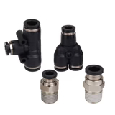What Are the Different Types of Air Fittings?

Figure 1: A variety of air fittings from left to right: standard air coupling, safety air coupling, large air coupling, and 2-way air coupling
Air fittings create a secure and leak-free connection between various components within a pneumatic system. Air fittings, also known as pneumatic fittings, come in a wide range of sizes, shapes, materials, and designs. Based on the type chosen, the air fitting may perform different functions, such as connecting hoses, regulating air pressure, directing airflow, and sealing off unused connections. This article takes a closer look at some common air fitting types and offers advice on selecting them for a specific application. Learn more about air fittings by reading our pneumatic coupling overview article.
Table of contents
- Standard air couplings
- Push-to-connect fittings
- Push-on fittings
- ISO 4414/EN 983 safety couplings
- Large air couplings
- Color coded air couplings
- Air coupling manifolds and multilinks
- Claw couplings
- Compression fittings
View our online selection of pneumatic fittings!
Air fitting types
There are many types of air fittings for various applications and system designs. This section covers several different types but is not comprehensive. Therefore, when selecting fittings for an application, be sure to consider the following requirements:
- Purpose: Air fittings have several functions, for example connecting two air hoses, changing airflow direction, or connecting an air hose to an air tool.
- Operating pressure and temperature: Different pneumatic applications have various working pressure and temperatures. Before selecting a fitting, check its manufacturer's specifications on max pressure and temperature to ensure the fitting can work in the application.
- Connection design: Understand the components that will be joined with the air fitting. These different components have specific connection types that the fitting must match.
- Coupling feature: Fittings can have specific features. For example, some are suitable for vacuum applications and others can have double-sided shutoff. This means the flow shuts off in both directions when the fitting is disconnected.
-
Material: Common materials for air fittings are brass, plastic, and stainless steel. Ensure the fittings material is suitable for the system's parameters. For example, plastic fittings typically operate up to a max temperature of 60 °C.
- Seal material: Different seal materials have different pressure and temperature ratings. Some materials have special properties necessary to understand. For example, in drinking water applications, EPDM seals are preferred over NRB seals because the former does not make a noticeable impact on the water's taste.
Standard air couplings
Standard air couplings (Figure 2) are also known as compressed air couplings, compressor couplings, air hose couplings, and pneumatic fittings. They have a diameter ranging from 2.7 to 7.2 mm. These couplings have two parts, the socket (internal threading) and plug or nipple (external threading). Standard air couplings are typically used to connect an air hose to an air tool. When disconnected, the socket closes to maintain the air hose's pressure.
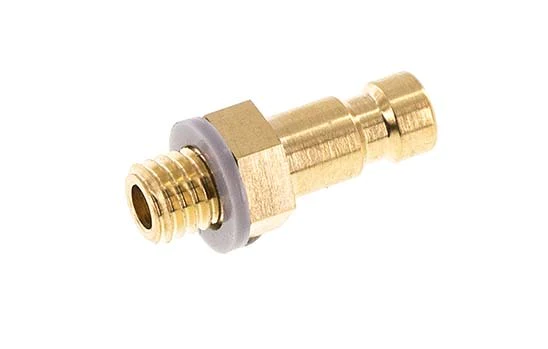
Figure 2: A standard air coupling
Push-to-connect fittings
Push-to-connect fittings, also known as push-in fittings, have an internal gripping mechanism that holds a hose or tube inserted into the fitting. These fittings allow for quick connections without the need for other tools.
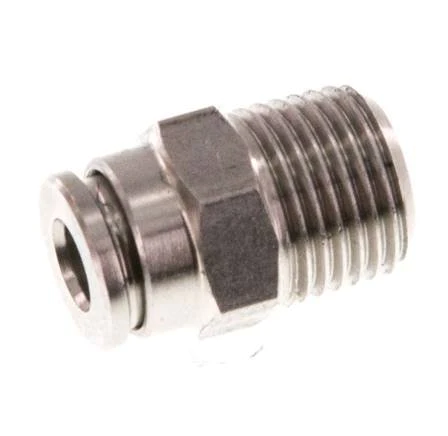
Figure 3: A stainless steel push-in fitting
Push-on fittings
Push-on fittings, also known as push-fit fittings, can connect plastic or copper tubes together. Within the fitting are stainless steel teeth that dig into the tube when the fitting is locked. This allows for a fast and strong connection.
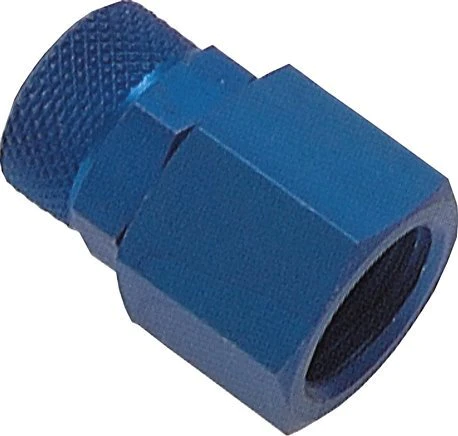
Figure 4: An aluminum push on fitting
ISO 4414/EN 983 safety couplings
Safety couplings safely shut off air flow when the coupling is disconnected. This prevents a whip effect that can damage the air tool and endanger the user. It also saves compressed air. These safety couplings meet safety requirements set by ISO 4414 and EN 983. Meeting these standards ensures the highest level of safety for users who use this coupling.
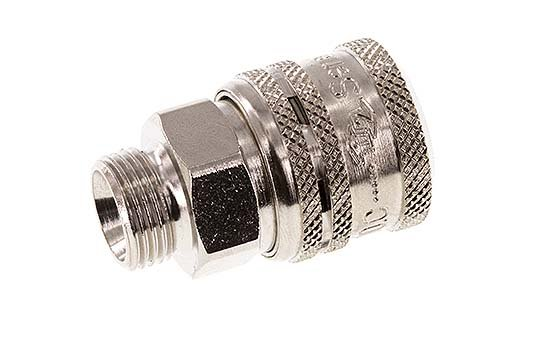
Figure 5: A safety air coupling
Large air couplings
Large air couplings have diameters ranging from 10 to 19 mm. They ensure efficiency in high-flow applications and are typically used in heavy machinery, construction equipment, and industrial applications.

Figure 6: A DN 10 large air coupling
Color coded air couplings
Color coded air couplings have different colored labels with varying shapes of connection (e.g., triangle, circle, or octagon). Different colored couplings cannot connect. The colors ensure that compatible plugs and sockets are connected, and incompatible plugs and sockets are not. This helps avoid accidents during operation. For example, when working with multiple gas lines that cannot mix, color coded fittings ensure this cannot happen.
Note: Color-coded fittings can fit with fittings that are not color-coded so long as said fittings are the same size and shape.
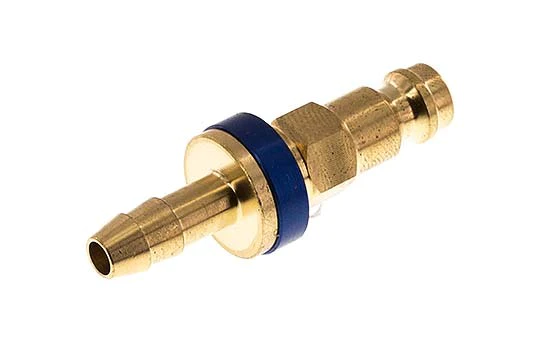
Figure 7: A color coded air coupling
Air coupling manifolds and multilinks
Air coupling manifolds and multilinks allow multiple air hoses to connect to a single air supply. They come in a variety of designs:
- DN 7.2 Euro: This style of air coupling can be mounted to a wall and has different input connection types (e.g., external and internal threads and plugs). The DN 7.2 Euro profile is the most popular coupling in Europe and works with any standard compressed air application.
- DN 7.2 Euro CEJN multilink distribution system: This multilink has a modular construction allowing for combinations up to five couplings.
- Multi-coupling: Multi-couplings (Figure 7) have several plugs that airlines can connect to. These are used to quickly change the air supply between air tools. Unused plugs close so air pressure is maintained.
- Multi-coupling bulkhead assembly: This multi-coupling is cost-effective, compact, and has a flat profile.
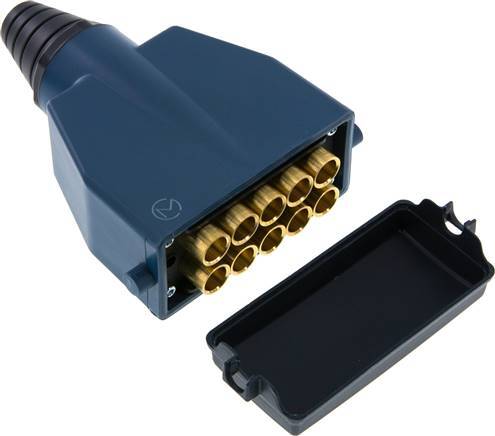
Figure 8: Brass multi-coupling plug with ten 6 mm push-in connections
Claw couplings
Claw couplings are typically used for harsh environments and larger air flow and hoses. These couplings have two claws on each side of the fitting, separated by 42 mm. Claw couplings are connected when two claw ends are pushed together and then turned until the claws are 45° apart. At this point they are locked in. Common DIN standards for claw couplings are DIN 3489 and DIN 3238, which provides extra security against accidental decoupling. The DIN 3489 coupling connects to the DIN 3238 coupling. DIN 3486 and DIN 3487 claw couplings are specific to the safe connecting and decoupling of throttle valves with claw couplings.
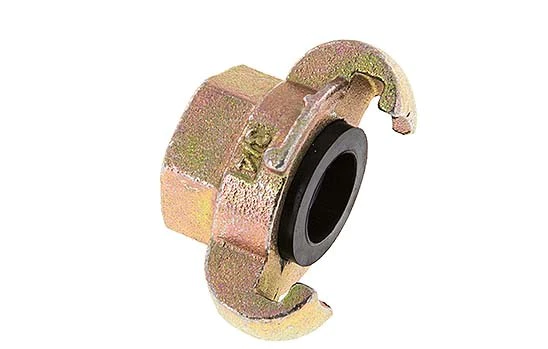
Figure 9: A cast iron claw coupling
Compression fittings
A compression fitting's nut and ring slide onto the pipe at the connection point. The end of the pipe inserts into the compression fitting's body. The compression nut tightens to the fitting's body and a strong connection forms. These fittings are ideal for making fast and easy connections.
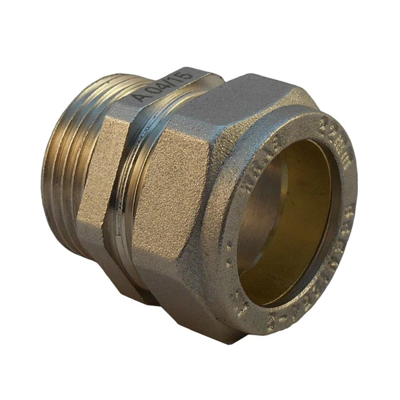
Figure 10: A compression fitting
Other designs
The following coupling designs are common in pneumatic systems to direct air lines and flows in specific directions:
- Straight fittings: Straight fittings are the simplest type. They form a 180° connection between two system components. They typically have a push-in connection type.
- Elbow fittings: Elbow fittings have a 90° angle between each side of the fitting. This works to change the direction of airflow in a system.
- Tee fittings: Tee fittings have three ports. This design allows for the splitting or combining of airflow in a system. For example, one air source can split to supply air to two air tools.
- Cross fittings: Cross fittings are similar to tee fittings, except they connect four components, typically in perpendicular, intersecting lines, instead of three.
FAQs
What is an air fitting?
An air fitting connects two or more components in a pneumatic system, for example, a hose to an air tool. Many types of air fittings are designed for specific purposes and operating conditions.
What is the most common air fitting style?
The most common air fitting type is the 7.2 mm (quarter inch) standard air coupling.




